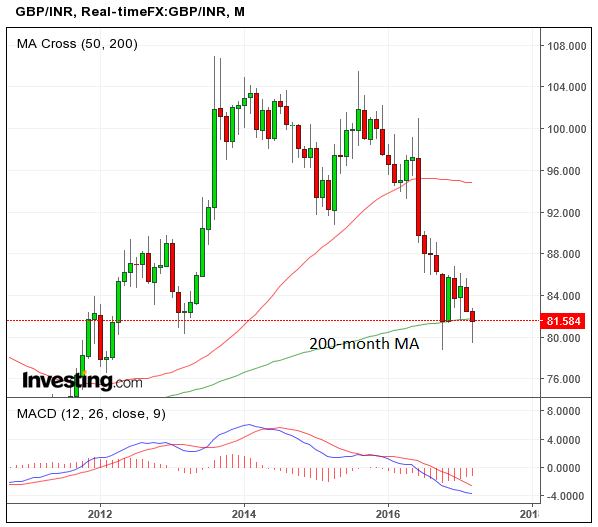Pound to Rupee X-Rate Rebounding Off Key Lows as Small Uptrend Evolves

There is a series of higher highs and lows on the four-hour chart (see below) which signifies that the Pound to Rupee exchange rate has established a very short-term uptrend.
This uptrend will probably extend with the next target level at 81.816 Rupee’s to the Pound.
This is the level of the 200-month moving average, and therefore of major significance.
Moving averages (MA’s) are dynamic levels of support and resistance which prices often bounce off and this MA may have the same impact on GBP/INR.
There is a strong possibility the 200-month could prevent further loses indefinitely and/or provide the basis for a reversal of the longer-term downtrend.
In any case, if the exchange rate reaches its zone around 81.81 it is likely to encounter volatile conditions.


The Rupee is a favoured currency by many analysts at the moment for a variety of reasons.
The first is that India is now the fastest growing economy in the world after taking over the mantel from China.
The second is that India is one of the least exposed economies to Trump’s protectionist trade stance, as it has less of a relationship with the US than many eastern Asian economies and China.
The Indian economy is more differentiated than most, not relying solely on one sector for its revenue but having an equally robust services and manufacturing sector.
India has benefited from the current low commodity prices as it is a net resources importer.
Finally, the current government is keen on reforming the economy and opening it up to more foreign investment, which is seen as a positive trajectory for the country.
The Rupee is in a strong position, therefore, vis a vis other emerging market currencies.
Lloyds Commercial Banking don’t see the Rupee in danger of falling as the central bank (RBI) has made it clear it is targeting inflation and therefore is more likely to raise interest rates than lower them, which is always positive for a currency.
They note the strong rally in the Rupee which accompanied Prime Minister Modi’s election win in the key state of Uttar Pradesh a few weeks ago.
“BJP party success in India’s local elections helped to push USD/INR to a two and half year low. The election result increases the chances that current reform-minded Prime Minister Modi will remain in power after the 2019 lower house elections,” said Lloyds.
They see downside risks emanating from the Rupee getting too strong and the RBI cutting interest rates to try to weaken it for the benefit of exporters.
Another risk is a rise in Crude Oil prices of which India is a net importer, however, Modi’s reforms are likely to offset this by attracting more foreign investment flows.






